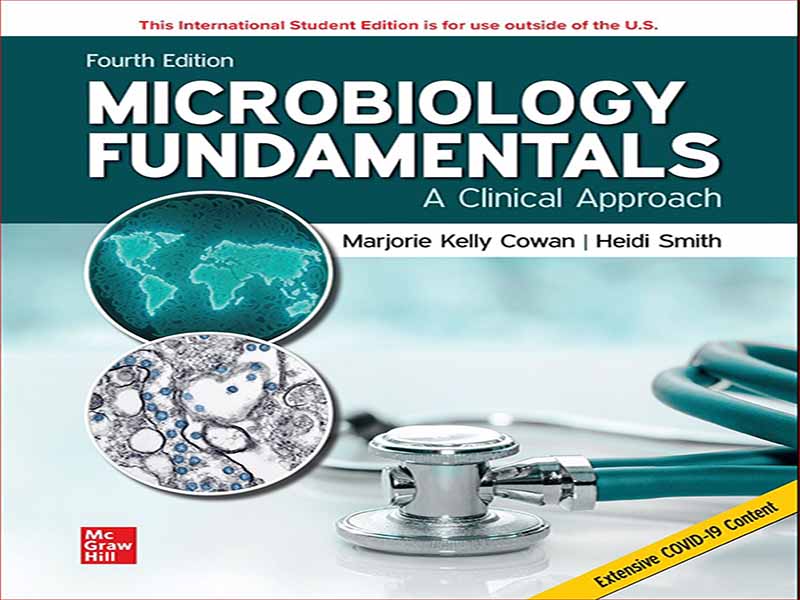- عنوان کتاب: Microbiology FUNDAMENTALS
- نویسنده: Marjorie Kelly Cowan
- حوزه: میکروبیولوژی
- سال انتشار: 2022
- تعداد صفحه: 1366
- زبان اصلی: انگلیسی
- نوع فایل: pdf
- حجم فایل: 74.8 مگابایت
میکروبیولوژی یک حوزه تخصصی از زیست شناسی است که به موجودات زنده ای می پردازد که معمولاً بسیار کوچکتر از آن هستند که بدون بزرگنمایی دیده شوند. چنین موجودات میکروسکوپی در مجموع به عنوان میکروارگانیسم ها (my″- kroh-or’-gun-izms)، میکروب ها، یا چندین اصطلاح دیگر بسته به نوع میکروب یا هدف نامیده می شوند. چندین گروه عمده از میکروارگانیسم ها وجود دارد که ما آنها را مطالعه خواهیم کرد. آنها می توانند سلولی یا غیر سلولی باشند. میکروارگانیسم های سلولی که ما مطالعه خواهیم کرد باکتری ها، باستانی ها، قارچ ها و تک یاخته ها هستند. یکی دیگر از ارگانیسم های سلولی که باعث عفونت انسان می شود، از نظر فنی یک میکروارگانیسم نیست. هلمینت ها حیوانات چند سلولی هستند که شکل بالغ آنها با چشم غیر مسلح قابل مشاهده است. میکروارگانیسم های غیر سلولی عامل بیماری های انسانی ویروس ها و پریون ها هستند. جدول 1.1 اولین نگاهی اجمالی به این میکروارگانیسم ها به شما می دهد. گروه بسیار مهم دیگری از موجودات به نام جلبک وجود دارد. آنها برای سلامت زیست کره حیاتی هستند اما مستقیماً انسان را آلوده نمی کنند، بنابراین در این کتاب آنها را در نظر نخواهیم گرفت. هر یک از هفت گروه دیگر شامل اعضایی است که انسان ها را مستعمره می کنند، بنابراین ما روی آنها تمرکز خواهیم کرد. ماهیت میکروارگانیسمها مطالعه آنها را هم بسیار آسان و هم بسیار دشوار میکند – آسان است زیرا آنها به سرعت تکثیر میشوند و ما میتوانیم به سرعت جمعیتهای زیادی را در آزمایشگاه رشد دهیم، و دشوار است زیرا معمولاً نمیتوانیم آنها را مستقیم ببینیم. ما برای تجزیه و تحلیل آنها علاوه بر استفاده از میکروسکوپ، به انواع روش های غیر مستقیم متکی هستیم. برای میلیاردها سال، میکروب ها به طور گسترده ای توسعه زیستگاه های زمین و تکامل سایر اشکال حیات را شکل داده اند. قابل درک است که دانشمندانی که در جست و جوی حیات در سیارات دیگر هستند، ابتدا به دنبال نشانه هایی از میکروارگانیسم ها هستند. ارگانیسم های تک سلولی حدود 3.8 میلیارد سال پیش بر اساس فسیل های موجود در این سیاره ظاهر شدند. یکی از این موجودات – که به آن LCA یا آخرین جد مشترک گفته می شود – در نهایت منجر به ظهور دو نوع تک سلولی جدیدتر به نام باکتری و آرکی شد. اندکی بعد این جد تک سلولی باعث پیدایش سلول های یوکاریوتی (yoo-kar’-ee-ot-ic) شد. نوع سلول معروف به LCA دیگر وجود ندارد. تنها “نسل” آن – باکتری ها، باستانی ها و یوکاریوت ها – باقی مانده است. Eu-kary به معنای “هسته واقعی” است و اینها تنها سلولهایی بودند که دارای یک هسته بودند. باکتری ها و باستانی ها هسته واقعی ندارند. به همین دلیل، آنها را به طور سنتی پروکاریوت (pro-kar’-ee-otes) می نامند که به معنای “پیش هسته” است. اما محققان پیشنهاد میکنند که دیگر از واژه پروکاریوت برای جمع کردن آنها استفاده نکنیم، زیرا باستانشناسی و باکتریها از نظر ژنتیکی بسیار متمایز هستند. برخی از دانشمندان شروع به نامیدن آنها آکاریوت به معنای “بدون هسته” کرده اند. اگر هفت نوع میکروارگانیسمی را که در این کتاب با آنها سر و کار خواهیم داشت در نظر بگیرید، باکتری ها و باستانی ها را به عنوان هر یک حوزه خاص خود را می شناسید. تک یاخته ها، قارچ ها و کرم ها همگی در حوزه یوکاریا هستند. ویروسها و پریونها روی درخت زندگی ظاهر نمیشوند، زیرا سلول نیستند و زنده محسوب نمیشوند. عجیب به نظر می رسد، اما ما در فصل ویروس که بعدا می آید به آن خواهیم پرداخت.
Microbiology is a specialized area of biology that deals with living things ordinarily too small to be seen without magnification. Such microscopic organisms are collectively referred to as microorganisms (my″- kroh-or′-gun-izms), microbes, or several other terms depending on the kind of microbe or the purpose. There are several major groups of microorganisms that we’ll be studying. They can be either cellular or noncellular. The cellular microorganisms we will study are bacteria, archaea, fungi, and protozoa. Another cellular organism that causes human infections is not technically a microorganism. Helminths are multicellular animals whose mature form is visible to the naked eye. Acellular microorganisms causing human disease are the viruses and prions. Table 1.1 gives you a first glimpse at these microorganisms. There is another very important group of organisms called algae. They are critical to the health of the biosphere but do not directly infect humans, so we will not consider them in this book. Each of the other seven groups contains members that colonize humans, so we will focus on them. The nature of microorganisms makes them both very easy and very difficult to study—easy because they reproduce so rapidly and we can quickly grow large populations in the laboratory, and difficult because we usually can’t see them directly. We rely on a variety of indirect means of analyzing them in addition to using microscopes. For billions of years, microbes have extensively shaped the development of the earth’s habitats and the evolution of other life forms. It is understandable that scientists searching for life on other planets first look for signs of microorganisms. Single-celled organisms appeared on this planet about 3.8 billion years ago according to the fossil record. One of these organisms—referred to as LCA, or the Last Common Ancestor—eventually led to the appearance of two newer single cell types, called bacteria and archaea. A little bit later this singlecelled ancestor gave rise to eukaryotic (yoo-kar′-ee-ot-ic) cells. The type of cell known as LCA no longer exists. Only its “offspring”—bacteria, archaea, and eukaryotes—remain. Eu-kary means “true nucleus,” and these were the only cells containing a nucleus. Bacteria and archaea have no true nucleus. For that reason, they have traditionally been called prokaryotes (pro-kar′-ee-otes), meaning “prenucleus.” But researchers are suggesting we no longer use the term prokaryote to lump them together because archaea and bacteria are so distinct genetically. Some scientists have started calling them akaryotes, meaning “no nucleus.” If you consider the seven types of microorganisms we will be dealing with in this book, you will recognize bacteria and archaea as each having their own domain. The protozoa, fungi, and helminths are all in the domain Eukarya. Viruses and prions do not appear on the tree of life because they are not cells, and not considered living. That sounds strange, but we will delve into that in the virus chapter, which comes later.
این کتاب را میتوانید بصورت رایگان از لینک زیر دانلود نمایید.
Download: Microbiology FUNDAMENTALS



































نظرات کاربران